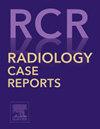复杂的上消化道出血:一例合并消化性溃疡和胃十二指肠动脉瘤破裂的儿科患者
Q4 Medicine
引用次数: 0
摘要
年长儿童的上消化道(GI)出血一般是由食管炎、食管静脉曲张破裂和消化性溃疡病等疾病引起的。然而,胃十二指肠动脉血管瘤破裂导致出血的情况并不多见,尤其是在伴有消化性溃疡病的情况下。本报告描述了一个病例,患者是一名 13 岁的男性,因严重的上消化道出血和血流动力学不稳定而需要输血。在一次急诊上消化道内镜检查中,发现了一个被归类为 Forrest IIB 的胃溃疡出血。最初通过内镜止血和手术缝合处理了出血。尽管采取了这些干预措施,患者还是反复出血。通过造影剂增强计算机断层扫描(CT)成像进行进一步检查,发现胃十二指肠动脉有一个血管瘤。数字减影血管造影术(DSA)证实,患者随后成功接受了血管内栓塞术。术后,患者没有再出现消化道出血。该病例突出表明,在处理复杂的消化道出血病例时,使用对比增强 CT 和内窥镜进行全面诊断评估至关重要。早期发现和适当干预至关重要,尤其是对于出血原因可能罕见且严重的儿科患者。本文章由计算机程序翻译,如有差异,请以英文原文为准。
Complex upper gastrointestinal bleeding: A case of combined peptic ulcer disease and ruptured gastroduodenal artery aneurysm in a pediatric patient
Upper gastrointestinal (GI) bleeding in older children is generally caused by conditions like esophagitis, esophageal variceal rupture, and peptic ulcer disease. However, it is rare for bleeding to result from a ruptured vascular aneurysm of the gastroduodenal artery, particularly when associated with peptic ulcer disease. This report describes a case involving a 13-year-old male who presented with severe upper GI bleeding and hemodynamic instability, requiring blood transfusion. During an emergency upper GI endoscopy, a bleeding gastric ulcer classified as Forrest IIB was identified. The bleeding was managed initially with endoscopic hemostasis and surgical suturing. Despite these interventions, the patient experienced recurrent bleeding. Further investigation with contrast-enhanced computed tomography (CT) imaging revealed a vascular aneurysm in the gastroduodenal artery. The patient subsequently underwent successful endovascular embolization, as confirmed by digital subtraction angiography (DSA). Following this procedure, there were no further episodes of GI bleeding. This case highlights the critical need for thorough diagnostic evaluation using contrast-enhanced CT and endoscopy in managing complex GI bleeding cases. Early detection and appropriate intervention are essential, especially in pediatric patients where the cause of bleeding may be rare and severe.
求助全文
通过发布文献求助,成功后即可免费获取论文全文。
去求助
来源期刊

Radiology Case Reports
Medicine-Radiology, Nuclear Medicine and Imaging
CiteScore
1.10
自引率
0.00%
发文量
1074
审稿时长
30 days
期刊介绍:
The content of this journal is exclusively case reports that feature diagnostic imaging. Categories in which case reports can be placed include the musculoskeletal system, spine, central nervous system, head and neck, cardiovascular, chest, gastrointestinal, genitourinary, multisystem, pediatric, emergency, women''s imaging, oncologic, normal variants, medical devices, foreign bodies, interventional radiology, nuclear medicine, molecular imaging, ultrasonography, imaging artifacts, forensic, anthropological, and medical-legal. Articles must be well-documented and include a review of the appropriate literature.
 求助内容:
求助内容: 应助结果提醒方式:
应助结果提醒方式:


